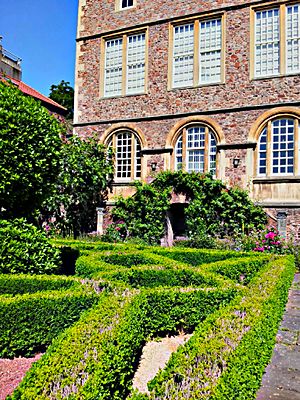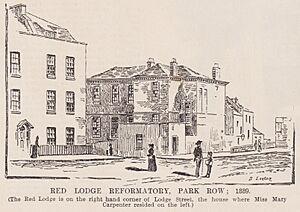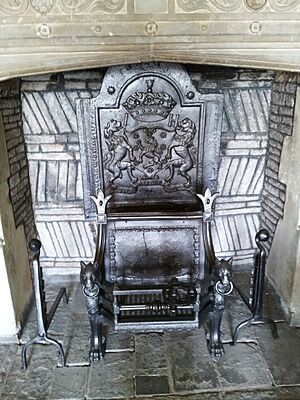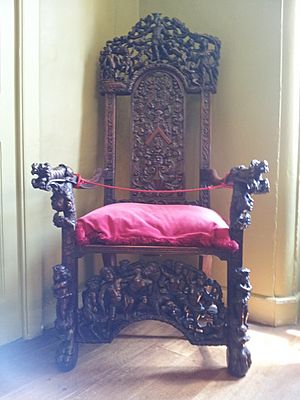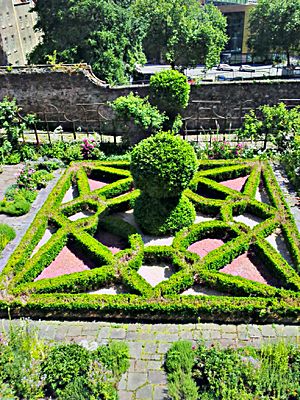Red Lodge Museum, Bristol facts for kids
Quick facts for kids Red Lodge Museum |
|
|---|---|
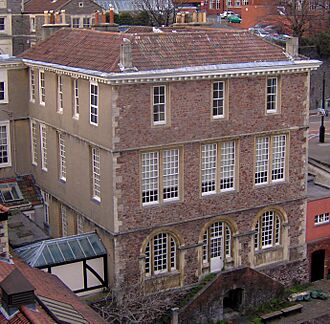
Red Lodge
|
|
| General information | |
| Town or city | Park Row, Bristol BS1 5LJ |
| Country | England |
| Coordinates | 51°27′20″N 2°35′58″W / 51.455556°N 2.599583°W |
| Completed | 1580 |
| Client | John Yonge |
The Red Lodge Museum is a really old house in Bristol, England, that you can visit! It was first built a long, long time ago, between 1579 and 1580. This was during the Tudor and Elizabethan times, when Queen Elizabeth I was on the throne.
The house has been changed and added to over the years, especially in the 1730s and early 1800s. Today, the Red Lodge is a free museum, but it relies on donations to keep running. It's looked after by Bristol City Council and is a great place to learn about history.
Contents
Discovering the Red Lodge's Past
How the Red Lodge Began
The Red Lodge was first built as a special guest house. It sat at the top of the huge gardens of a bigger house called "ye Great House." Sir John Young built the Great House in 1568. He was an important person who worked for King Henry VIII and Queen Elizabeth I.
The Young family would take their guests through their beautiful gardens and orchards to the Red Lodge. There, they would enjoy meals and entertainment. It was a fancy place for parties and visits!
Sir John Young passed away in 1589. His wife, Dame Joan, finished building the Red Lodge in 1590. She came from a well-known family and was the sister of Nicholas Wadham, who helped start Wadham College, Oxford. Queen Elizabeth I even stayed with the Youngs at the Great House in 1574. You can see the family's special symbols carved above the entrance to the Great Oak Room at the Red Lodge.
Later, Sir John and Dame Joan's son, Robert Young, inherited everything. But he spent his money quickly. To avoid losing the Red Lodge, he gave it to his half-brother, Nicholas Strangways. By 1595, the Red Lodge was rented out to different people and became a separate home from the Great House.
Big Changes by John and Mary Henley
In the 1730s, a couple named John and Mary Henley bought the Red Lodge. They made huge changes, adding a whole new section to the north side. This made the house twice as big! They put in large Georgian windows and changed the roof style. This gave the house a full second floor.
The Henleys also updated some rooms, like the Reception Room and the Parlour. But they left other rooms, such as the Great Oak Room, mostly untouched. This means we can still see the beautiful old Tudor decorations today!
Sadly, John Henley died before all the work was finished. Mary Henley couldn't inherit the house because they didn't have children. John's will said she could live in the Red Lodge for one month each year. This made it hard to rent or sell the house for a long time.
Doctors and a New Entrance
After the Henleys, doctors who worked at the Bristol Royal Infirmary rented the Red Lodge. One famous doctor was James Cowles Pritchard, who wrote important books about people's history. Other doctors, Francis Cheyne Bowles and Richard Smith, used the Great Oak Room for medical studies. In the 1800s, the main entrance we use today from Park Row was added, along with more rooms on the east side.
Mary Carpenter and the Girls' School
In 1854, a kind lady named Lady Byron bought the Red Lodge. She gave it to Mary Carpenter to start a school. Mary Carpenter was a passionate reformer who wanted to help poor girls. She opened the first-ever Girls' Reformatory at the Red Lodge. This school offered new and caring ways to help girls, instead of sending them to harsh workhouses or prisons, which was common in the Victorian era.
The Red Lodge was a reform school until 1917. Mary Carpenter worked hard as the school's leader. She traveled the world and spoke to important people to improve the lives of poor children.
Becoming a Museum for Everyone
In 1919, James Fuller Eberle saved the Red Lodge. He bought it to stop its historic insides from being sold off. He bought it for the Bristol 1904 Arts society and the Bristol Corporation. The arts society later moved to a new building in the garden. This left the Red Lodge, with its Tudor, Georgian, and Victorian parts, to the corporation, which is now Bristol City Council.
The Council fixed up the building in 1920 and again in 1956. Then, they opened the Red Lodge as a museum! Since then, it has been part of the Bristol Museum & Art Gallery family. Other museums in this family include The Georgian House Museum and Blaise Castle House Museum.
Today, the museum is working on making the New Oak Room even better and making the garden safer for visitors.
Exploring the Rooms of the Red Lodge
The Great Oak Room
The Great Oak Room is one of the most amazing rooms in the house! It still has its original oak walls, a fancy plaster ceiling, and a unique "double-decker" fireplace. It's considered one of the best rooms in the West Country of England. You enter through a wooden porch, just like in some other grand old houses. Above the porch, you can see the Young and Wadham family symbols carved into the wood. The only big change here is the larger Georgian windows, which give a lovely view of the knot garden.
The Small Oak Room and Bedroom
These rooms were built at the same time as the Great Oak Room, but they are not as grand. The Bedroom has a plaster ceiling with a design that inspired the knot garden outside. In Tudor times, people would move from public rooms to more private ones. So, the Great Oak Room was for guests, while these smaller rooms were likely private spaces or bedrooms.
The Print Room
The Print Room was added in the 1700s. The museum has made it look just like a typical Print Room from that time. You can see beautiful tiles around the fireplace and fancy wooden patterns on the furniture. There's also a tall "japanned" clock, which means it has a special shiny finish. These items show what was fashionable in the early 1700s.
The Mary Carpenter Room
This room tells the story of the Red Lodge as a school. You'll find a painting of Mary Carpenter with her first student and a photo of her. There's also Mary Carpenter's own piano, which she bought for the house in 1845.
The Grand Staircase
The big Georgian staircase and landing are impressive. They have portraits of important people connected to the house, like John and Mary Henley. The staircase was designed with many windows and a large chandelier. This would have made it very bright and grand for Mary Henley and her guests as they walked to the Reception Room.
The Reception Room and Parlour
Even though these rooms are part of the original Tudor house, the Henleys changed them a lot to make them look fashionable in the Georgian style. In the Reception Room, you can see where an old wall used to be. It was removed to make the room much bigger.
The Parlour has a mix of old Tudor oak walls and newer Georgian wooden walls. It also has an original fancy plaster ceiling. Some parts of the room were changed in the 1800s, blocking off old bay windows.
The New Oak Room and the Well
The New Oak Room was changed a lot in the 1800s. In 1965, the museum used old parts from other buildings to decorate it. The wooden walls came from another old church, and the fireplace came from Ashley Down House.
The Second Floor
The Henleys also changed the Tudor attic, which had pointy gables. They made it into a full second floor, giving the house more space.
Special Things to See
Queen Elizabeth I's Portrait
In the Great Oak Room, there's a portrait of Queen Elizabeth I. Experts have recently said it's an original painting from the late 1500s!
The Speke Chair/Table
Look for a special chair in the Great Oak Room that can fold down to become a table! Furniture that could do two jobs was common in Tudor times.
Portrait of Florence Smyth and her 'Page'
In the Small Oak Room, you'll find a painting of Florence Smyth and a young boy. We don't know much about the boy, but this painting might be one of the earliest pictures of a person of color in the UK.
Mary Carpenter's Piano
The piano in the Mary Carpenter Room is the actual Broadwood piano that Mary Carpenter bought in 1845. The fabric on the front of these pianos is usually silk. It's possible that the girls at the school helped embroider the fabric on this one.
1700s Spinet
In the Print Room, there's a spinet, which is a bit like a small piano. It was made by Benjamin Slade in 1702. It's been at the Red Lodge for a long time and is still played for special events.
Walnut Bureau with Hidden Spots
The wooden desk and shelves in the Reception Room have many secret compartments! Can you imagine hiding treasures there?
The Skinner Chair
The Skinner Chair in the Parlour was carved in the late 1600s for Bishop Robert Skinner. The carvings on the chair tell the story of Actaeon the Hunter. He made the goddess Artemis angry and was turned into a deer, then attacked by his own hunting dogs.
The chair also has the Skinner family's special symbols. This chair has been used on two royal visits! Prince Albert sat on it in 1843, and Edward VII sat on it in 1908.
The Beautiful Knot Garden
When you look out from the Parlour or Great Oak Room, you'll see a lovely Knot Garden. This garden was created in the 1980s to look like a garden from Elizabethan times. The box hedges are shaped into a "knot" pattern, just like the design on the Bedroom ceiling! Herbs and flowers are mixed together, just as they would have been in the 1630s. All the plants in the garden would have been common back then.
Red Lodge in Modern Times
Art and Performances
The Red Lodge isn't just for history; it's also used for art! In 2006, there was a special art show with modern sculptures. The artists created works that fit with the old house but also made you think.
The Red Lodge has also been a stage for plays and a setting for films. In 2013, Galliard Films made an online video about the Red Lodge's history. In 2016, the Red Lodge was featured in a BBC Four TV show about Queen Elizabeth I.
In December 2020, a local poet named Emma Williams wrote poems about the girls who lived at the Red Lodge when it was a reform school. She used Mary Carpenter's old journals to imagine their lives.
Other Places to Visit


